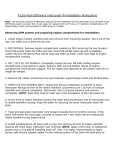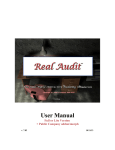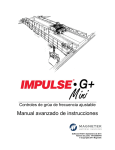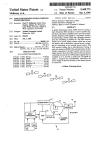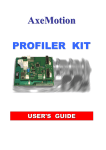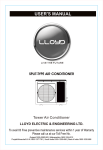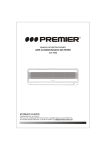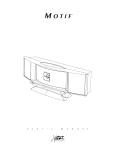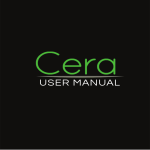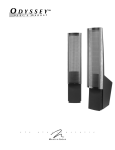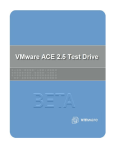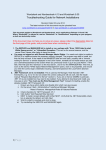Download User Manual - Swanson
Transcript
Swanson’s, Inc. Company Background Swanson’s is an apparel chain in the Northeast. Major product categories include coats and outerwear, suits, dresses, skirts, blouses, sweaters, hats, shoes, and accessories. Jennifer Swanson started the business with the objective of providing stylish attire and accessories to professional women, aged twenty-five to forty-five with an emphasis on individualized attention. After thirty years in the business, she decided to sell men’s attire at one of the stores. The first Swanson store was opened in a Rochester shopping mall in 1972. Jennifer Swanson served as store manager, and was assisted by two full-time sales clerks and a part-time clerk helping on weekends. The store prospered, and in 1974 Ms. Swanson decided to expand the operation with additional outlets. At the same time, she incorporated in the State of New York with herself as president. The chain now has twenty stores distributed in metropolitan areas throughout New York and Connecticut, and Swanson is now contemplating further expansion into New Jersey. Three of the stores were named Jennifer’s after their founder. The corporate headquarters is still in Rochester, but several years ago all administrative activities were moved to a suite in a suburban office park. The original Rochester store is now treated in the same way as any other store. Because of the expansion, Jennifer Swanson is now almost totally engaged in directing the business and selecting lines of merchandise. Along with her merchandise manager, Anthony Rollins, recently hired from a prominent fashion design house, Swanson regularly attends fashion shows and trade fairs, in New York City and other major cities. They also spend a considerable amount of time visiting clothing manufacturers throughout the country. Headquarters staff includes the merchandise manager (who supervises the buyers); a general manager, Sally DeStephano, a financial manager, Nancy Woo, a human resource manager, and a systems administrator. Also on the staff are three assistant buyers, two marketing specialists, three inventory control clerks, five accountants, a part-time internal auditor, and clerical support. Corporate Governance Oversight of management's activities at Swanson's, Inc. is the responsibility of its Board of Directors and its part-time internal auditor. They also have an external auditor as required by their bank to maintain its long-term debt relationship. As its principal stockholder, Jennifer Swanson holds the voting control of the corporation and elects the Board and serves as its Chairman. In addition to herself, there are three other board members including Anne Hector, President of Fashionista, Ltd., Thomas Griffin, President of Fashion House, Inc., and Jane Swanson, external legal counsel. Hector and Griffin serve on the compensation committee and Jane oversees its financial and external audit relationships. In the past, Jennifer Swanson has made the final decision regarding selection of its CPA firm Analazzi and Foote, LLP. The board meets monthly to review its financial performance and to approve corporate strategy. Last year, Jennifer and Jane decided to hire a part-time internal auditor. Stephanie Middleton who works approximately thirty-five hours a week. For various financial, strategic, and retirement planning reasons, the Swansons thought that it might be a good idea to explore the possibility of taking the company public or to merge with a larger public company that specialized in woman's fashions. In a recent meeting with the Swansons Stephanie said, "Although we are not a public company, to become one we would have to comply with the new SEC regulations required by the Sarbanes-Oxley Act of 2002. The regulations are new and require that public companies maintain an internal control system over its financial reporting that complies with the new COSO Integrated Internal Control Framework. I am familiar with it, but think that we ought to hire an outside SOX consultant to assist in doing a COSO feasibility study. With your permission, I could place an ad on craigslist.com to find one. Even if we don't go the IPO or merger route, improving our internal control could save the company money by reducing cash shortages and inventory shrink and improving overall efficiency. It would also help us review our general IT strategy and control." Information Systems and Technology Twenty-five years ago, Swanson’s bought a minicomputer to perform routine accounting and other data processing and hired two full-time computer operators. In 1993, they acquired 30 personal computers for headquarters personnel. The PCs had Intel 486 – 66 Mhz processors with 8 MB of RAM and 420 MB hard drives. Each one had a 3 ½” diskette and a 14” color monitor. Their main applications software was WordPerfect 6.1 and Lotus 1-2-3 ver.5 running on Windows 3.1. In 1996, the 486’s were replaced with Pentium 300 Mhz based computers with 16 MB of RAM and 800 MB hard drives. These computers also came with a 3 ½” diskette and a 15” color monitor. Since most of the wordprocessing and speadsheeting needs were being met by their current applications software, they just reinstalled WordPerfect and Lotus 1-2-3 on the new computers. In 2001, Ms. Swanson acquired laptop computers for herself, Rollins, and the assistant buyers, which they use primarily on their trips to trade shows. In 2002, they replaced their 30 desktops with 30 new computers running Windows 2000 on AMD 1800 processors , 256 MB of RAM, and 40 GB hard drives. For wordprocessing and spreadsheets they just reinstalled their existing applications. In 2006, Ms. Swanson replaced the laptops for herself , Rollins, and the assistant buyers with white Apple MacBooks. She was so in love with her white 30 GB iPod, that she just had to get the matching laptops. After some brief discussion with the system administrator, she decided to replace WordPerfect and Lotus 1-2-3 with Open Office 2.0, which they freely downloaded from the Internet. They also decided to obtain Net Zero Platinum accounts for their employees to connect to the Internet and have access to e-mail. They are also looking into replacing their corporate desktops. Recently, Jennifer Swanson expressed concerns about the effects of changing information systems technology on her business. Traditionally, she has viewed technology as an expensive distraction from her core focus of providing personal service to her customers. Increasingly, however, she has heard stories about competitor and industry web sites that make her wonder if she might be too old-fashioned. After some lengthy conversations with Nancy Woo, Ms. Swanson allowed her to set up a basic Web site for the purpose of establishing a web presence. Since the Company was not setup to do it internally, Nancy searched the web and found an outside firm to host their new site. It cost $19.95 a month and Nancy uploaded the web content from her Internet connection at home. Nancy had learned how to create simple web pages in college, so she designed the content herself in HTML. The site included a home page with some pictures and buttons to additional pages about us, locations, and how to contact the company. A few months later, Ms. Swanson held a meeting to discuss the Web site and a big argument ensued. The sales department felt that the company was losing money because there was no virtual tour, sales promotions, or mailing lists to increase sales. Furthermore, they argued there is no way to purchase gift certificates or merchandise on the site. Human resource responded by stating that what they really needed was an employment application to address their staff shortage and not more sales. Finally, accounting warned that these initiatives would be expensive and that accepting transactions over the Web was risky and required specialized accounting controls. The meeting concluded with Swanson wondering what they 2 should do about the situation, if anything, and Nancy Woo arguing that using ROI would resolve the problem. Retail Stores The retail stores are located in major shopping malls, and they typically occupy about 2,000 square feet of floor space. Each store is run by a store manager who supervises an assistant manager and four to five sales clerks. The stores are evaluated as profit centers, and managers are given a fair amount of autonomy as long as their stores are profitable. Building demand in a new market takes time, but sales and profits are monitored closely by headquarters. Stores are normally given one year to demonstrate profitability. If a store fails to do so, Swanson decides whether to extend the probation period, replace the manager, or close the store. So far, only two stores have been closed, in each case because the mall in which the store was located did not grow as fast as anticipated. New store managers are usually recruited from the ranks of the assistant managers of existing stores. Store profit is defined, for performance-evaluation purposes, as segment margin: net sales revenue less direct and allocated indirect costs. Direct costs include the cost of merchandise sales, rent, utilities, salaries and sales commissions, local advertising, credit card fees, and miscellaneous expenses. Indirect costs include corporate overhead costs allocated to stores at a rate of 15 percent of gross sales. In return for this overhead allocation, the corporation performs all collections and payroll services and also pays for major product and institutional advertising. As discussed later, stores are charged a separate burden to cover centralized purchasing expenses. Purchasing and Merchandise Policies and Procedures Buying in the apparel business requires a good feel for fashion trends, but inevitably is subject to considerable risk. Merchandise must be displayed three to four months before the selling season and must be ordered six to nine months before expected delivery. During that period, fashions and consumer taste may change, and what seems to be a promising new trend may fizzle out. For example, the Paris and New York fashion houses may all be showing skirts four inches above the knee, but consumers may ignore their lead and continue to insist or longer skirts. Buying for Swanson’s is centralized at the Rochester headquarters because of both the needed expertise and the risk involved. Swanson and her buyers select the lines of merchandise to be carried, and these are shown to store managers at quarterly meetings. However, inventory decisions are completely decentralized, and managers are free to choose the quantities of each item and the colors, styles, and sizes to be carried in their particular stores. Each store manager prepares a purchase requisition listing his or her merchandise requirements and submits it to Rochester. Purchase orders are then sent to the supplier, ordinarily requesting direct shipment to the local store. Purchase requisitions from different stores may be consolidated into a single purchase order in cases where volume discounts are available from a particular supplier. In this situation, the merchandise is normally shipped to the company headquarters and is subsequently distributed to local retail stores. An Inventory Transfer Report (a kind of internal shipping notice) is prepared, listing the items sent to the store in question. However, some vendors are willing to divide up a purchase order and make partial shipments to individual stores, thereby cutting delivery lead time and saving shipping costs. 3 All merchandise is checked upon delivery to local retail stores. Store managers or their assistants prepare prenumbered Receiving Reports, listing the quantity and condition of the merchandise received. Copies of these reports are forwarded to Rochester either for reconciliation with headquarters' receiving reports or for recognition of accounts payable. All disbursements to vendors are made from Rochester. Damaged garments or goods that were not ordered are returned to suppliers, and a Goods Returned Report is sent to headquarters. Acceptable items are tagged with the inventory number, coded cost, and price. After the manager or assistant manager verifies the tag data for accuracy, the merchandise is ready to be displayed on the racks. No cash changes hands when a retail store receives merchandise, but the store's account is charged for the wholesale cost plus a 5 percent burden to cover purchasing costs. This policy is followed whether or not the goods are shipped directly to the store. Sales Policies and Procedures Swanson Stores sells merchandise off the racks and also issues its own gift certificates. Gift certificates, which can be exchanged for merchandise in the future, are available in denominations of $25, $50, $100, and $200. The company also offers a lay-away plan, although relatively few customers currently take advantage of this once-popular service. Cash, debit, and credit-card sales are entered into a cash register that produces a customer sales slip and a paper-tape record of the stock number, the sales clerk's identification code, and the price of the item. Tags removed from merchandise are accumulated for comparison with the paper-tape records at the end of the day. Checks are accepted upon submission of suitable identification, normally a driver's license and major credit card. Sales involving checks for more than $100 must be authorized by the store manager or assistant manager. If checks bounce, the store can turn them over to the corporate office for collection. Ultimately, if the amount cannot be collected, it is charged to the store's account. Only Visa, MasterCard, and Discover cards are currently accepted. Debit and credit-card policies require approval of all charges by running the customer’s card through a scanner. If the scanning system is not working, sales clerks must call for approval and insert the approval code on the charge slips. The merchant's copies of the charge slips are accumulated in a drawer under the cash register for reconciliation with the cash-register tape at the day's end. Stores are charged a fee of 3 percent of gross debit and credit-card sales by the credit-card companies and banks, but are not held responsible for any associated bad debts. Gift certificates accepted in exchange for merchandise are canceled by a rubber stamp and then placed in the drawer under the cash register. Company policy is to accept return of merchandise for a refund within fifteen days of sale, on the condition that the garment has not been worn and the sales slip is submitted. A Merchandise Return slip is filled out and authorized by the store manager or assistant manager. If the returned garment is in satisfactory condition, it is put back on the racks for resale at either the full or a reduced price. Garments that are damaged or that have been soiled by the customer may still be accepted for a refund, but they must be marked down for resale. If the garment was considered defective at the time of sale, a Goods Returned Report is completed and the garment is returned to the vendor for credit. Clearance sales are held in January and August. The August sale occurs near the end of the fiscal year and serves to reduce inventory levels before the annual physical inventory count at each store. 4 Sales clerks get a basic salary from headquarters, plus a commission of 2 percent of their gross sales from the store. However, 5 percent of each employee's commission is withheld until year-end to provide an allowance for sales returns. Monthly statements are prepared, showing the clerk's gross sales, gross commission, current month's withholding, and net commission paid. The statements also show the year-to-date gross withholding, offsetting sales returns, and net withholding. Clerks who have followed company policies relating to customer identification are not held responsible for bad checks. Additional Accounting Policies and Procedures Store managers are responsible for preparing Daily Cash Reports and monthly Operating Summary Reports. The cash reports provide an accounting of all cash received, disbursed, and deposited as well as gift certificates issued and customer Returns (due bills issued). The reports for the previous week must be submitted to the corporate headquarters every Monday. The Operating Summary Reports are submitted at month's end. They show gross cash, credit-card, and gift-certificate sales for each of the major product lines and out-of-pocket expenses broken down into account categories specified by the firm's chart of accounts. Canceled gift certificates are sent to headquarters with the operating reports. Each retail store maintains a local bank account into which all cash and checks are deposited and on which checks are drawn in payment of local rent, utilities, advertising, and miscellaneous expenses. Both the store manager's and the assistant manager's signatures are required on all checks, and disbursements must be recorded in a check register. Bank deposit slips are completed in triplicate. The bank retains the master copy, a second copy is returned to the store, and the third is forwarded to the corporate headquarters at the end of each month. The bank has instructions to send one copy of its monthly statement to headquarters and a second copy to the store. Store managers are responsible for performing the routine bank reconciliation and are required to send a copy of the reconciliation, together with a copy of the check register, to headquarters at the end of the month. The store managers prepare their routine reports and budgets on personal computers and submit the required data on spreadsheet printouts, although two still do them manually. At headquarters, data from the Daily Cash Reports and Operating Summary Reports are keyed into the minicomputer system for processing. The screen input form used for entry of the retail stores' operating data is currently being redesigned. After the data from each retail store have been accumulated, corporate overhead and purchasing expenses are allocated. Monthly Operating Statements are then prepared and distributed to the retail stores. Each of these statements includes the aggregate data for the whole corporation as well as operating data for the individual store. Detailed results for one store are not made available to the managers of other stores. Required: Systems Thinking Questions 1. Identify the components of Swanson’s accounting information system. Organize them into the three basic categories: people, technologies, and controls. Are any trade-offs involved in implementing controls? 5 2. Is Swanson taking advantage of information technology (e.g., POS terminals, real-time inventory, messaging and collaboration tools, B2C E-commerce, etc.) to gain a competitive advantage? Explain why or why not. Where are they on the System Technology Maturity Model? Where should they be? 3. Identify at least three keys to success in this line of business and the extent to which accounting information is required to address them. 4. Identify the accounting cycles present in Swanson and whether any are in need of improvement. 5. Explain how a merchandise expenditure transaction is initiated and how it flows through the cycle. 6 Explain how a revenue transaction is initiated and how it flows through the cycle Developing Systems Questions During a recent meeting with Jennifer Swanson she expressed concerns about the effects of changing information systems technology on her business. She requested that your group investigate the following questions and report back to her as soon as possible: 7. I am hearing a lot of conflicting reports about whether we should upgrade our computers from Windows 2000 to something else (e.g., Windows XP, Linux, Mac OS X or should we wait for Vista). How are these systems different from what we have now? What are our needs and are they being met? Do we need to consider our existing hardware, networking, or the Internet? I have also heard that a number of entities (like Google, Amazon, Disney, the State of Massachusetts, and the City of Munich among many others) have saved millions of dollars by moving to open source software. Might we be better off with open source? 8. Does Swanson need a more sophisticated web site? What are their needs and what would strategic planning tell them? Would it be more difficult and expensive to set one up? Estimate the relevant costs and benefits. Use a spreadsheet to do an estimated ROI. 9. Do you think Swanson needs any type of groupware (e.g., messaging and collaboration tools)? Key decision factors? Who would benefit? Generally, what would be required to implement any of this? Would a local area network or intranet be required? Evaluating Systems Questions 10. Does Swanson have to use the COSO framework to evaluate its accounting systems? In your opinion, (independent of your answer to the first question) should Swanson utilize the COSO framework? 11. Review Swanson's corporate governance structure. Then, using the accompanying simulation software to the Swanson case, make an assessment of its entity-level controls using the COSO framework and the accompanying internal control questionnaire (ICQ) included in the simulation. After completing the ICQ, evaluate each of the COSO components at the entity level using the Control Systems Maturity 6 Model. Then, assign a rating to the entity-level control overall (i.e., combine your ratings of the individual COSO components into one overall rating). Finally, identify any areas that should be improved and discuss their related benefits and costs. 12. Conduct a walkthrough of the revenue cycle. Will this enable you to understand how it works? Using an internal control questionnaire, does the revenue cycle seem adequately designed given its controls objectives? What are its strengths and weaknesses. If there are weaknesses, are any significant or material? Finally, rate the cycle using the Control Systems Maturity Model. 13. Conduct a walkthrough of the expenditure cycle. Write a short summary of how it works. Using an internal control questionnaire, is the expenditure cycle adequately designed given its controls objectives? What would you say are its strengths and weaknesses. Are any weaknesses significant or material? Finally, rate the cycle using the Control Systems Maturity Model. 14. If Swanson's, Inc. were a public company, what would it have to do to comply with Section 404 of the Sarbanes-Oxley Act? 15. How much of the 404 compliance work is likely to be done by management? Do you think executive management is qualified to evaluate accounting controls? 16. Prepare a general outline of what would be included in management’s documentation of internal control over financial reporting for SOX 404 including some examples. 17. Could Section 404 requirements affect a company’s decision to go public? If so, why and how. 7 Exhibit A Swanson’s, Inc. Combined Income Statements For Years Ended December 31, Sales Cost of Sales This Year $120,916,000 63,900,000 Last Year $119,740,000 63,100,000 Gross margin 57,016,000 56,640,000 Selling, general and administrative expenses 51,674,000 50,590,000 5,342,000 720,000 4,622,000 6,050,000 815,000 5,235,000 1,432,820 $3,189,180 1,622,850 $3,612,150 Operating income Interest expense Income before income taxes Income taxes Net income Combined Balance Sheets December 31, ASSETS Current Assets: Cash Short-term investments Receivables, net Inventories Other current assets Total current assets Property, plant and equipment: Accumulated depreciation Other assets LIABILITIES AND EQUITY Current liabilities: Accounts payable Accrued expenses Current portion of long-term debt Income taxes payable Other current liabilities Total current liabilities Long-term debt Deferred taxes Stockholders' equity Common stock Capital in excess of par value Retained earnings Total stockholders' equity 8 This Year Last Year $1,425,000 1,433,000 4,258,000 28,590,000 2,495,000 38,201,000 58,925,000 $1,725,000 1,989,000 3,980,000 25,500,000 1,546,000 34,740,000 58,350,000 (24,205,000) 2,649,000 $75,570,000 (21,800,000) 2,509,000 $73,799,000 $8,820,000 4,309,000 701,000 772,000 713,000 15,315,000 10,900,000 725,000 26,940,000 $8,922,000 4,100,000 701,000 790,000 650,000 15,163,000 11,601,000 525,000 27,289,000 1,900,000 12,150,000 34,580,000 48,630,000 $75,570,000 1,900,000 12,150,000 32,460,000 46,510,000 $73,799,000 Appendix A Swanson Stores Interactive Simulation User Guide Overview In this interactive computer simulation, which extends the case, you are placed incharge of a SOX 404 internal control consulting assignment and given a series of tasks to complete. The tasks range from getting to know the client to making an assessment of their entity-level and activity-level controls. At the beginning of each phase of your systems consulting assignment, you will receive an overview of what needs to be done by Nancy Woo, the Financial Manager. Then, you will need to follow the work program and enter your findings after each task. Your performance will be judged on your success in interviewing the client, your ability to evaluate the entity-level and activity-level controls, and your ability to identify any significant deficiencies or material weaknesses. In addition, you may be required to present your findings and recommendations for improvement. Installation 1. Open your Internet browser and download the software setup file from http://realaudit.com/simulations.html After clicking Download Information on the left menu and the Obtain Swanson Interactive SimulationTM link on the web page, you should be prompted to save the setup file. It is recommended that you save it to your desktop for easy access (or to whatever folder you prefer). 2. After the download is complete, you need to double click the setup file icon and follow the installation instructions. The software will then be accessible from your Start menu under Programs, then Swanson, then The Swanson Stores Simulation. IMPORTANT: Be sure the Swanson installation runs all the way to the end and that you are able to click the Finish button. If the setup file reports an error message during the installation and does not finish, you will need to delete the corrupted setup file from your desktop and download a fresh copy from http://realaudit.com/simulations.html From time to time, files downloaded from the Internet can be corrupted by filters or bandwidth management software installed on busy college networks. We apologize for this inconvenience, but it does happen sometimes. 9 The Swanson Stores Interactive Simulation - An In-Depth Guide First steps - The menu After you launch the game from the Windows Start menu and click Continue on the game title screen, you will see the initial game menu: New Game: Use this button to start a new session. It is recommended that you run through the simulation at least twice since there is a great deal of information to remember. Load Game: Use this button to retrieve a previously saved game. It is also highly recommended that you save (see Save on the in-game menu) using a different name each time in case you would like to pick up from a previous state without having to start a whole new game. Quit: Choose quit when you want to leave the simulation and return to Windows. The login screen: At the login screen, please type in your account name (which is the e-mail address you registered with) and your password. Then, click the login button to connect to the realaudit.com registration server. You will need an active Internet connection to use this software. You may also login to the simulation on any computer it is installed on provided that you are using your personal e-mail address and password (for e.g., school, work, home, etc.) 10 The initial briefing After logging in to the realaudit.com server, you will be given a quick overview of the Swanson case assignment and then taken to the office for an initial briefing from Nancy Woo, the Financial Manager. Click Instructions to begin the briefing, then click Continue to proceed. At the end of the initial briefing, you should proceed directly to the consultant's virtual desk. The consultant's 11 virtual desk, the interactive work program, and the dialoguing engine are the three main interface elements of the simulation. The consultant's virtual desk This is where planning the SOX consulting assignment begins. To get an overview, start by clicking Yes on the Help panel and continue to the end. The work program can be accessed by clicking the button with that name in the lower right of the virtual desk. The work program is organized according to the two phases of consulting assignment: 1. Evaluating Entity-Level Control and 2. Evaluating Activity-Level Control. Now visit the Financial Manager by clicking Financial Manager on the evidence list (items will be added to the list as you progress through the simulation), and then click Inquire. Documentation and people listed on the consultant's virtual desk can be accessed by clicking the desired item and then clicking the desired work procedure below. For example, you can open the internal control checklists by clicking their names and then clicking Inspect. You may also accomplish a number of other tasks at the consultant's virtual desk such as answer the phone, move on to the next phase of the assignment, open the work program, and access the ingame simulation menu: Answer the phone - right click on the phone (to answer it) when it rings (this feature has been reserved for future use) 12 Work Program - click here to open the work program. The work program is where you keep track of the tasks to be performed and your findings. Using the work program effectively is key to knowing what has been done and what procedures remain. Menu - click here or press Esc to open the in-game simulation menu. Use this menu to quit the game when you are done. You may also save your progress during the game or when you quit. The consulting assignments Once you have mastered using the consultant's virtual desk, you are ready to begin the consulting assignments. The first assignment in most courses will be to get to know the client and to evaluate their entity-level control using the COSO framework. To accomplish this you will need to conduct interviews, inspect documentation, and complete internal control questionnaires. After completing your evaluation of entity-level control, you will be assigned to evaluate one of the transaction cycles (or more depending on your professor's instructions). To accomplish this you will need to obtain a walkthrough of the cycle from the client and assess the adequacy of their controls relative to the control objectives. Dialoguing engine for client inquiries In order to talk with the client, choose one of the sentences listed below the consultant. The client will then respond to that question automatically (or you may choose to pause the client responses and then advance them with the space bar). Do not click on what the client is saying. To make a choice, move the cursor over one the sentences until it turns into a pointing 13 finger and then click to select that choice. In the example below, the question "Are there some criteria for requisitions?" is being chosen. Choose wisely, as your actions may have an effect on the outcome of the simulation. 14 Improving Your Oral Presentations Accounting Systems, Dr. John A. Schatzel Goal: To combine significant content, clear organization, and enthusiastic delivery into a single package of effective communication. I. Organization: A. Emphasize the main idea of your presentation. B. Identify and link the key information that relates to main idea and combine them effectively. C. Provide facts, arguments, and examples to sell your ideas and to make the presentation concrete to the listeners. II. Delivery: A. Plan out and create visual aids to help the audience understand and follow your presentation. B. Rehearse with your group until you are comfortable. Give each other feedback to facilitate improvement. C. Once you are happy with the content and organization of the presentation, concentrate on delivery techniques. Effective presenters usually: stand with good posture, minimize unnecessary hand and arm gestures, maintain eye contact, project their voices, maintain a comprehensible pace, smile periodically, show enthusiasm and demonstrate that they are enjoying themselves. 15 Presentation Checklist Presenter's name ___________________ Reviewer's name ___________________ I. Organization Main idea Linkage Facts, arguments, examples to sell ideas II. Delivery Visual aids Presence Eye contact Voice Pace Enthusiasm III. Lasting impressions 16
















